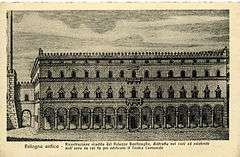Palazzo Bentivoglio, Bologna

The original Palazzo Bentivoglio was a palace in Bologna, destroyed by the mob in 1507. A second palace by the same name was built nearby, and is still standing.
History
The palace of the noble Bolognese family of Bentivoglio was built on the orders of Sante Bentivoglio, in San Donato street (today the Via Zamboni), starting in 1460, and was subsequently completed by Giovanni II Bentivoglio. Contemporary chroniclers and scholars have attempted to reconstruct the appearance of the great house on the basis of often enthusiastic descriptions. The main facade facing onto the street San Donato measured 30 meters, while the sides were over 140 meters in length. Located on the ground floor were the apartments of the men of the house of Bentivoglio, while the upper floor held the apartment of Giovanni II, richly frescoed, and the equally sumptuous apartment of Ginevra Sforza and the other women of the house. The building also housed the guards and soldiers, guest rooms, warehouses and depots of arms. The building had 244 rooms in total. In it, the Bentivoglio received illustrious characters and friends, and gave sumptuous dinners and parties.[1]
Destruction
The building was destroyed by popular fury in the spring of 1507. The decision to destroy it was made by the enemies of the Bentivoglio. Even Pope Julius II was convinced that it was necessary to raze the house of tyrants if you wanted to prevent their return. With the expulsion of the family from the city of Bologna, the Senate decreed that any emblem or sign of past domination most be destroyed. The destruction of the palace of San Donato street was, however, a great loss for the story of Italian art. [1] Today the area where the palace stood is the Municipal Theatre, which runs to the right of the Via del Guasto (Failure road), whose name recalls the fate of Bentivoglio house. The modern Giardino del Guasto, a small public garden created in 1975 by the architect Rino Filippini, covers the area formerly occupied by the garden of the palace.
Later developments
A little further on, in Via Delle Belle Arti, stands the imposing new Palazzo Bentivoglio. It was built, starting in 1551, by Costanzo Bentivoglio, a descendant of a collateral branch (non-dominant) of the family. The architect Bartolomeo Triachini is attributed with the design of the majestic and beautiful later palace. The entrance leads into a spacious courtyard surrounded by a double loggia that was based on designs by Domenico Tibaldi. It was completed by Giovanni Battista Falcetti in the first half of the seventeenth century. The upper floor of the new palace has a number of halls that have ceilings and friezes from the Tibaldi school. There is a large gallery painted by in chiaroscuro style Antonio Bonetti with sculptures by Ubaldo Gandolfi. The gallery was opened in 1769 when senator Fulvio Bentivoglio became Gonfaloniere of Bologna.[2]
Notes and references
Citations
Sources
- Antonelli, Armando; Poli, Marco (2006). Il palazzo dei Bentivoglio nelle fonti del tempo. Venezia: Marsilio. ISBN 8831791958.
- "Bartolomeo Triachini, Palazzo Benitvoglio (1551)". Comune di Bologna. Retrieved 2013-01-14.
Further reading
- Carlo Pancaldi, Descrizione storica del palazzo Bentivoglio atterrato nell'anno 1507, in "Almanacco Statistico Bolognese" (1830), pp. 145–160,
- Pier Luigi Perazzini, Nuovi documenti riguardanti il distrutto palazzo Bentivoglio di strada San Donato, in "Strenna storica bolognese", 47 (1997), pp. 405–424
- Pier Luigi Perazzini, Nuovi documenti riguardanti il distrutto palazzo Bentivoglio di strada San Donato, 2, in "Strenna storica bolognese", 50 (2000), pp. 395–414
- Un signore allo specchio: il ritratto e il palazzo di Giovanni II Bentivoglio, catalogo della Mostra tenuta a Bologna nel 2003 a cura di Vera Fortunati, Bologna 2003